Botox
There are two categories of facial wrinkles: static and dynamic. Static wrinkles are visible when your face is at rest and occur during the aging
process because of the loss of elastic tissue. Dynamic wrinkles appear temporarily when a muscle contracts during facial expression (i.e. smiling,
frowning). Dynamic wrinkles are commonly found in areas of facial expression like the forehead (worry lines), between the eye brows (glabellar lines), and around the eyes (crow’s feet).
BOTOX® Cosmetic diminishes or even eliminates the appearance of dynamic wrinkles because it paralyzes the underlying muscle causing the wrinkle. When injected directly into the muscle, the purified Botulinum toxin type A prevents the muscle from contracting by blocking the transmission of nerve impulses to the muscle. Because the muscle cannot contract, the wrinkle cannot form and as a result it gradually diminishes.
BOTOX® Cosmetic is not as effective on static wrinkles which are better treated surgically or with dermal fillers.
How many treatments do you need?
The amount of relaxation and the length of time the relaxation lasts depend on three factors:
– The size and strength of the muscle being injected.
– Your sensitivity to the medication.
– The amount of Botox injected into the muscle
The first two factors vary between individuals so you may require more or less medication than another person to produce the same results. The effects of Botox injections normally last for three to six months.
Typical units needed per site:
What can I expect?
BOTOX® Cosmetic is injected directly into the muscle which causes the dynamic wrinkles. A very small needle is used to minimize discomfort and the injection feels like a small prick accompanied by a little stinging. The entire procedure takes about 10 minutes and since the procedure is non-surgical, no recovery time is needed so patients can immediately return to work or other activities.
How BOTOX® Cosmetic Works
The BOTOX® Cosmetic enters the nerve endings and blocks the release of acetylcholine, a chemical that causes muscles to contract. The paralysis takes 1 to 5 days to occur and peaks in two to four weeks with results lasting from three to six months. Because the effect gradually wears off, owing the dynamic wrinkle to return, follow up treatments are necessary to maintain the desired result. Like any other muscle that is not exercised, muscles treated with Botox become weaker over time. If you follow a good maintenance program, your next injections will occur when the relaxation begins to wear off but just before the muscles can form wrinkles again. At this time, there are still residual effects from the earlier injections. Repeat treatments may lead to improved results as the muscle causing the wrinkles becomes less responsive over time, a process called
chemical denervation.
BOTOX® Cosmetic Side Effects
BOTOX® Cosmetic can’t be used if there is an infection at the proposed injection site(s) or in individuals with known hypersensitivity to any
ingredient in the formulation (the milk protein Casein). Also, patients with neuromuscular disorders such as Myasthenia Gravis and Eaton Lambert Syndrome may be at increased risk of clinically significant systemic effects from typical doses of BOTOX® Cosmetic. The most common side effects are headache, respiratory infection, flu-like syndrome, temporary eyelid droop, and nausea. Less frequently occurring (<3%) side effects include facial pain, injection site redness, and muscle weakness. These events are thought to be associated with the injection and occurred within the first week.
About one person in ten thousand (.01%) can form antibodies that inactivate Botox and prevent it from relaxing the injected muscles.
Makeup may be applied after the treatment, but you should avoid pressing or rubbing the area for several hours.
Disclaimer:
This information is intended only as an introduction to this procedure. Details and treatment options will be discussed at your consultation.





